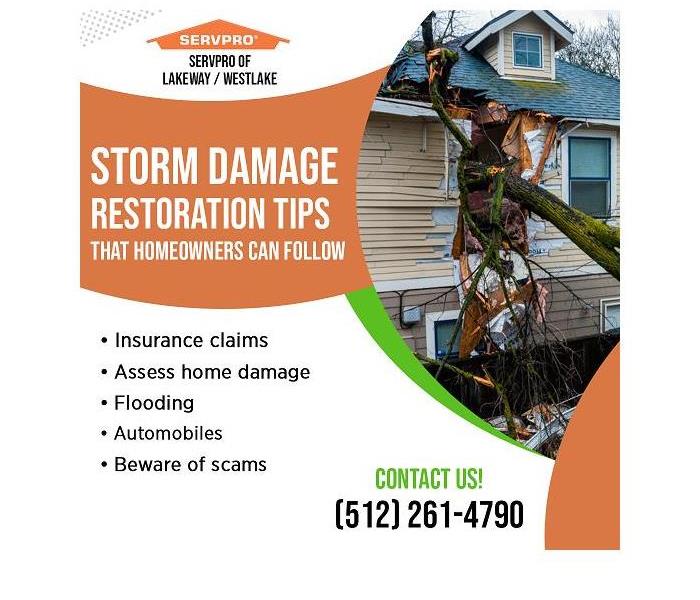SERVPRO: Storm damage tips for homeowners
8/24/2021 (Permalink)
Blog summary: This SERVPRO article explains the initial steps property owners can take after the storms have ceased.
Storm damage tips
A tornado, hailstorm, or thunderstorm can cause devastation for miles. These natural occurrences can lead to severe property damage, including flooding and wind damage. SERVPRO, a storm damage restoration service, shares the following storm damage restoration tips that homeowners can follow.
Insurance claims
Irrespective of DIY or professional restoration, insurance must be taken care of first.
- Take photos of the damage as proof to the insurance agent at the earliest.
- Homeowners’ insurance generally covers sudden, accidental damage such as a tree falling and damaging the house roof during high winds and thunderstorms.
- But some homeowners' policies may exclude windstorms and hail damage. Read the policy thoroughly or talk with the insurance agent.
- Since flooding from natural disasters is generally not covered in these policies, homeowners need to buy separate flood insurance from The National Flood Insurance Program.
Assess home damage
If homeowners have evacuated the house, they must receive the safety clearance from the local authorities before returning to the house. Basic safety precautions must be followed after the storm such as avoiding fallen power lines and standing water.
Plumbing - Water damage is highly likely after a storm due to the flash floods and sewage backup.
Inspect the pipes inside and outside the house (irrigation systems).
- Switch off the water supply. If not possible, at least turn off the water valves to toilets and sinks.
- Sewage backup in the shower or under the toilet indicates a clogged or broken sewer line. This is an issue best managed by a professional team.
Roofing - A damaged roof is a candidate for further water damage.
- Inspect the roof for missing shingles. However, some roof damage may not be visible from the ground and would need an expert inspection. A professional roofing team such as SERVPRO can help.
- Often there may be a need for a temporary solution to prevent the water from seeping in. A professional team can address this until a permanent solution is found and applied.
- A professional team has the expertise and the equipment to address roofing issues and prevent any further damage.
Electrical
- The electricity supply must be switched off.
- Appliances exposed to water must be serviced by an expert before being used.
- Watch out for frayed wires and sparks.
- Exposed wires are a danger and require the attention of an electrician. The power should remain off until the electrician has assessed the situation.
- Exterior breaker boxes, although rain-tight, may succumb to a major storm. Any water infiltration in the box must be addressed by an electrician and only then should the power be turned on.
- Avoid metal fences as they may be an electrocution risk due to dangling utility wires.
- Branches or trees that have fallen on power lines must be cleared or cut by a professional team.
3. Flooding
A flooded house is best addressed by a professional restoration company such as SERVPRO with its state-of-the-art equipment, experience, and IICRC certifications.
For a DIY restoration, homeowners must use protective gear such as boots, gloves, eye protection, and a respirator.
- Mitigate the water damage by removing standing water as soon as possible.
- Use a pump or squeegee the standing water.
- Use a vacuum only if it’s a true wet-dry vacuum.
- Remove all contents that may have absorbed the contaminated floodwaters such as carpeting, carpet padding, furniture, and drapes.
- Use air movers and dehumidifiers to dry out the area. Homeowners may have to purchase or rent this equipment.
- Dispose of all medicines, cosmetics, and foods that have been submerged in floodwaters.
- Inspect the walls and floors for hidden moisture, and remove the damaged portions to prevent mold growth. However, a thorough detection of moisture requires sophisticated devices that homeowners may not have access to.
- Clean floors and cabinets with detergent and then disinfect them.
- Keep photographic documentation of the damaged items that are being disposed of, for insurance purposes. A professional team may have a more discerning eye when it comes to identifying items that are salvageable.
- Automobiles
- Automobiles may get easily damaged by floodwaters, tree branches, or debris.
- An insurance agent must be notified of any automobile damage.
- Temporarily cover broken windows to prevent further damage.
- Create an inventory of valuables that are lost or damaged in the car.
- Beware of scams
It is not uncommon for scams to emerge during these catastrophes. However, by following certain criteria during the hiring process, homeowners can ensure they are not taken advantage of.
- Work with local and renowned contractors. Ask for reviews and recommendations.
- Pay when the task is completed and is at par with industry standards. Preferably pay with a check or a credit card.
- Beware of any “now or never” offers from contractors.
- Ask for a written estimate of damage and cost.
- Hire companies that are licensed and certified by IICRC.
Why SERVPRO?
- SERVPRO uses state-of-the-art equipment to bring the damaged property back to its original state. SERVPRO of Lakeway / Westlake is always updating its fleet and equipment so clients in Lakeway, West Lake Hills, or anywhere else can quickly access the services.
- With over 1,700 US and Canadian Franchise locations, SERVPRO is strategically positioned to respond faster to an emergency of any magnitude.
- The SERVPRO staff is highly trained in property damage restoration. They receive initial in-house training and constant skill up-gradation at the corporate training facility and also acquire the regular IICRC-industry certification.
For storm damage restoration services, in Austin, TX, and surrounding areas, call SERVPRO of Lakeway / Westlake today at (512) 261-4790.

 24/7 Emergency Service
24/7 Emergency Service
